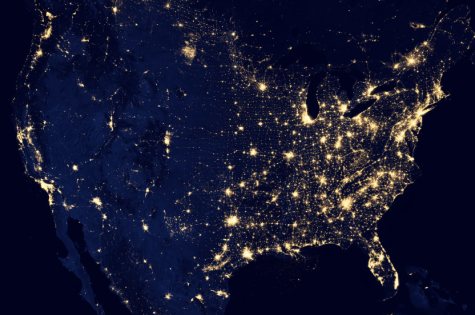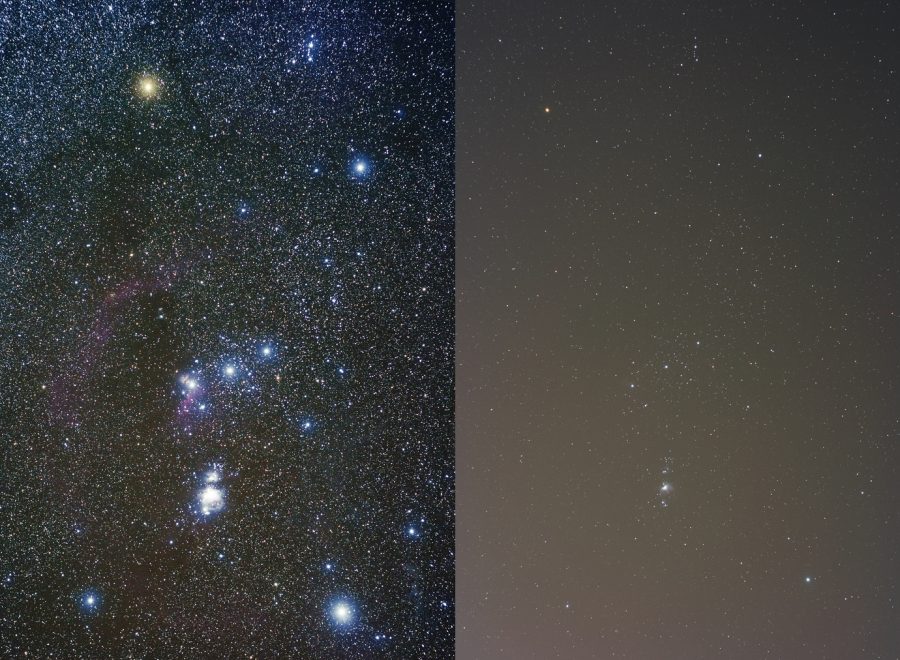Light Pollution: The Overlooked Environmental Crisis
February 24, 2023
What is Light Pollution?
When you look up “the night sky” on Google you will see high-quality images, usually vibrant night skies accompanied by the Milky Way and other fascinating celestial objects. However, when you step outside, there is no apparent Milky Way streaking through the middle, nor are there many visible stars in sight either. Science News reports that, according to over 50,000 observations by citizen scientists, the night sky has gotten brighter by 10% in the last 10 years.
However, the issue of light pollution is more complicated than not being able to see the stars at night—it interrupts biological behavior in wildlife, disrupts our circadian rhythm, and contributes to other environmental issues, such as increased CO2 in the atmosphere. National Geographic defines light pollution as “the excessive or inappropriate use of outdoor artificial light” when it is not necessary, such as at certain times of the night. Especially in urban areas and metropolitan cities, light pollution has converted night into an artificial day.
What are the causes and types of light pollution?
The types of light pollution include glare, clutter, light trespass, and sky glow. Glare is excessive brightness that causes visual discomfort, such as blinding car headlights that cause visual discomfort. Clutter is a large grouping of excessive amounts of light, such as groups of street lights, lit signs, or advertisements. Light trespass is when light “trespasses” into areas where it is not needed, leading to potential disturbances for people and animals who live there. Finally, sky glow is the hazy and cloudy glow over a city, which contributes to the overall brightening of the night sky.
According to the International Dark-Sky Association, “Light pollution is a side effect of industrial civilization. Its sources include building exterior and interior lighting, advertising, commercial properties, offices, factories, streetlights, and illuminated sporting venues.” In many urban areas, this has been the result at night, with over-stimulating signs, busy streets, and lit-up buildings. However, the crisis is not limited to only night-time, because anytime light is used over an area or period of time when it is not needed, it still counts as light pollution!
What are the consequences of light pollution?

One of the most critical effects of light pollution is its intrusive factor. For millions of years, Earth has existed in a day/night pattern that organisms have adapted to. Now that bright lights have taken over the night sky, that delicate balance has been broken. Scientific studies have shown evidence that light pollution has disrupted migration patterns and habitats. For example, turtles (which are naturally guided by the moon) are confused by lights and other stimulants, and can accidentally wander off-course or even into traffic. In addition, light pollution can affect groups of migrating birds. Many migrating birds are attracted to artificial light, and as a result, may meander into cities and collide with tall skyscrapers.
Another consequence of light pollution is the disruption of our own circadian rhythm, the internal clock that regulates the sleep-wake cycle and other activities. At night, the human body produces a hormone called melatonin, which encourages sleep. Artificial light at night lowers the human body’s melatonin levels which can result in sleep deprivation. “And when we don’t get that hormone… then the whole working of this biological system becomes problematic,” Dr. Christopher Kyba said in an interview. As a result, fatigue, headaches, stress, and other health problems can arise from light pollution, and also surprisingly, from blue light emitted by phones and computers.
In addition, light pollution has contributed to other environmental crises such as the increase of CO2 in the atmosphere. An overuse of lights leads to a large waste of energy, which in turn has major economic and environmental repercussions. Electric bills can rise in cost, demands for resources can increase, and more CO2 will be emitted into the atmosphere to keep up with all the high demands of lighting.
What are possible solutions to this crisis?
As a start, turning off lights when unnecessary is a simple solution. Although many people know of this solution, people fall out of the old habit and take it for granted. Secondly, minimizing the number of lights used in households is important, because it helps save energy, lower the cost of electrical bills, and combats light pollution at the same time. In addition, using blinds and other covers to shield light is beneficial as it prevents any unnecessary light from shining out where it is not needed (e.g. out of windows to neighbors). Another solution concerning driving at night would be to keep car windshields, mirrors, and headlights clean, in order to reduce visual discomfort or glare.
Equally important, designers and manufacturers can also help with the matter by designing street lamps and other light fixtures differently. Designers can use softer hues of colors instead of blue light to make street lamps more visual-friendly for humans and other animals. Also, using dimmer amounts/shades of light can help conserve energy usage, and motion detectors for lights can aid in the goal of only using light when it is needed. Lastly, shielding the light downward helps prevent unwanted light to scatter into the sky.
Spreading the word about light pollution to society is imperative so that people are informed about the crisis. Of all of the environmental issues, light pollution is severely overlooked, although its severity has skyrocketed in the past decade. While it is impossible to completely eliminate light pollution in major cities, taking the steps to reduce its impact will drastically help in the long run.



















































































































































